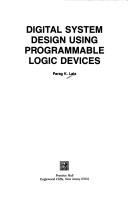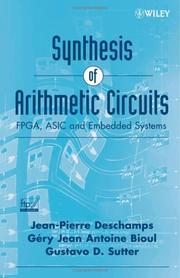
ISBN: 0132150883 Year: 1990 Publisher: S.l. Prentice Hall
Abstract | Keywords | Export | Availability | Bookmark
 Loading...
Loading...Choose an application
- Reference Manager
- EndNote
- RefWorks (Direct export to RefWorks)
digitale elektronica --- PLD (Programmable Logic Device) --- Computer. Automation --- Electronics --- programmeerbare logica --- Programmable logic devices. --- Digital electronics. --- Dispositifs logiques programmables --- Electronique numérique --- 681.31 )* INFORMATICAHARDWARE --- Programmeerbare logische schakelingen --- Programmeerbare logische schakelingen. --- Electronique numérique --- Digital electronics --- Programmable logic devices --- Logic devices --- Digital circuits --- Digital techniques (Electronics) --- Electronic systems

ISBN: 0135734789 0133984885 0130464112 Year: 2003 Publisher: Upper Saddle River, N.J. Prentice Hall
Abstract | Keywords | Export | Availability | Bookmark
 Loading...
Loading...Choose an application
- Reference Manager
- EndNote
- RefWorks (Direct export to RefWorks)
Digital electronics --- Logic circuits --- Electronique numérique --- Circuits logiques --- 681.32 --- Digitale techniek --- Electronique numérique --- PLD (Programmable Logic Device) --- FPGA (field programmable gate array) --- Circuits, Logic --- Interface circuits --- 681.3 --- Computers --- Electronic circuits --- Switching circuits --- Switching theory --- Digital circuits --- Digital techniques (Electronics) --- Electronic systems --- Electronics --- Computerwetenschap --- Circuits --- Contains audio-visual material --- digitale technieken --- elektronica --- 681.3* / / / / / / / / / / / / / / / / / / / / / / / / / / / /

ISBN: 9780471687832 Year: 2006 Publisher: Hoboken Wiley-Interscience
Abstract | Keywords | Export | Availability | Bookmark
 Loading...
Loading...Choose an application
- Reference Manager
- EndNote
- RefWorks (Direct export to RefWorks)
A new approach to the study of arithmetic circuits In Synthesis of Arithmetic Circuits: FPGA, ASIC and Embedded Systems, the authors take a novel approach of presenting methods and examples for the synthesis of arithmetic circuits that better reflects the needs of today's computer system designers and engineers. Unlike other publications that limit discussion to arithmetic units for general-purpose computers, this text features a practical focus on embedded systems. Following an introductory chapter, the publication is divided into two parts. The first part, Mathematical Aspects and Algorithms, includes mathematical background, number representation, addition and subtraction, multiplication, division, other arithmetic operations, and operations in finite fields. The second part, Synthesis of Arithmetic Circuits, includes hardware platforms, general principles of synthesis, adders and subtractors, multipliers, dividers, and other arithmetic primitives. In addition, the publication distinguishes itself with: * A separate treatment of algorithms and circuits-a more useful presentation for both software and hardware implementations * Complete executable and synthesizable VHDL models available on the book's companion Web site, allowing readers to generate synthesizable descriptions * Proposed FPGA implementation examples, namely synthesizable low-level VHDL models for the Spartan II and Virtex families * Two chapters dedicated to finite field operations This publication is a must-have resource for students in computer science and embedded system designers, engineers, and researchers in the field of hardware and software computer system design and development. An Instructor Support FTP site is available from the Wiley editorial department.
Digitale elektronica --- Logische schakelingen --- fpga (field-programmable gate array) --- asic --- embedded system --- pld (programmable logic devices) --- Digitale elektronica. --- Logische schakelingen. --- Computer arithmetic and logic units --- Digital electronics --- Embedded computer systems --- Embedded systems (Computer systems) --- Digital circuits --- Digital techniques (Electronics) --- Arithmetic and logic units, Computer --- Computer systems --- Architecture Analysis and Design Language --- Electronic systems --- Electronics --- Computer arithmetic --- Electronic digital computers --- Circuits

ISBN: 1134193173 128037702X 9786610377022 0203099818 9780203099810 0415372410 9780415372411 9781134193172 9781134193127 1134193122 9781134193165 1134193165 9780415654418 0415654416 6610377022 Year: 2005 Publisher: London New York, N.Y. Routledge
Abstract | Keywords | Export | Availability | Bookmark
 Loading...
Loading...Choose an application
- Reference Manager
- EndNote
- RefWorks (Direct export to RefWorks)
Examines the impact the 1993 general election had on Japanese politics. Although the Liberal Democratic Party (LDP) regained the position of a ruling party within a year, the author questions whether the Japanese political system has managed to maintain the same efficacy as it had prior to 1993.
Fiscal policy --- Jiyū Minshutō. --- Japan. --- MOF --- Japana. --- M.O.F. --- 日本. --- Jiyūtō (1950-1955) --- Nihon Minshutō --- Jimintō (Japan) --- Jiyūminshutō (Japan) --- Liberal Democratic Party (Japan) --- Liberalʹno-demokraticheskai︠a︡ partii︠a︡ I︠A︡ponii --- Liberalʹno-demokraticheskai︠a︡ partii︠a︡ (Japan) --- LDP --- Tzu yu min chu tang (Japan) --- 自由民主党 --- 自由民主黨 --- Partido Liberal Demócrata (Japan) --- PLD --- Japan --- Politics and government --- Economic policy. --- Jiyu Minshuto.
Book
ISBN: 9780367149239 9780429053931 1032238542 9781032238548 Year: 2020 Publisher: London Routledge, Taylor & Francis Group
Abstract | Keywords | Export | Availability | Bookmark
 Loading...
Loading...Choose an application
- Reference Manager
- EndNote
- RefWorks (Direct export to RefWorks)
Political parties --- Japan --- Jiyū Minshutō --- Jimintō (Japan) --- Jiyūminshutō (Japan) --- Liberal Democratic Party (Japan) --- Liberalʹno-demokraticheskai︠a︡ partii︠a︡ I︠A︡ponii --- Liberalʹno-demokraticheskai︠a︡ partii︠a︡ (Japan) --- LDP --- Tzu yu min chu tang (Japan) --- 自由民主党 --- 自由民主黨 --- Partido Liberal Demócrata (Japan) --- PLD --- Jiyūtō (1950-1955) --- Nihon Minshutō --- History. --- Politics and government --- J4655 --- Japan: Politics and law -- central government -- political parties
Book
Year: 2021 Publisher: Basel, Switzerland MDPI - Multidisciplinary Digital Publishing Institute
Abstract | Keywords | Export | Availability | Bookmark
 Loading...
Loading...Choose an application
- Reference Manager
- EndNote
- RefWorks (Direct export to RefWorks)
Despite its limitation in terms of surface covered area, the PLD technique still gathers interest among researchers by offering endless possibilities for tuning thin film composition and enhancing their properties of interest due to: (i) the easiness of a stoichiometric transfer even for very complex target materials, (ii) high adherence of the deposited structures to the substrate, (iii) controlled degree of phase, crystallinity, and thickness of deposited coatings, (iv) versatility of the experimental set-up which allows for simultaneous ablation of multiple targets resulting in combinatorial maps or consecutive ablation of multiple targets producing multi-layered structures, and (v) adjustment of the number of laser pulses, resulting in either a spread of nanoparticles, islands of materials or a complete covering of a surface. Moreover, a variation of PLD, known as Matrix Assisted Pulsed Laser Evaporation, allows for deposition of organic materials, ranging from polymers to proteins and even living cells, otherwise difficult to transfer unaltered in the form of thin films by other techniques. Furthermore, the use of laser light as transfer agent ensures purity of films and pulse-to-pulse deposition allows for an unprecedented control of film thickness at the nm level. This Special Issue is a collection of state-of-the art research papers and reviews in which the topics of interest are devoted to thin film synthesis by PLD and MAPLE, for numerous research and industry field applications, such as bio-active coatings for medical implants and hard, protective coatings for cutting and drilling tools withstanding high friction and elevated temperatures, sensors, solar cells, lithography, magnetic devices, energy-storage and conversion devices, controlled drug delivery and in situ microstructuring for boosting of surface properties.
Technology: general issues --- thin films --- matrix-assisted pulsed laser evaporation --- shellac --- enteric coatings --- PLD --- ITO --- nanoimprint lithography --- coatings --- nanostructure --- iron oxide --- pulsed laser deposition --- aluminum nitride --- nanoindentation testing --- TEM imaging --- FTIR spectroscopy --- ellipsometry --- complex refractive index --- composite coatings --- MAPLE --- Lactoferrin --- macrophage interactions --- animal-origin calcium phosphate coatings --- natural hydroxyapatite --- doping --- high adherence --- pulsed laser deposition technique --- biomimetic applications --- target preparation --- room temperature ferromagnetism --- dilute magnetic semiconductor --- Indium oxide --- (InFe)2O3 --- PLD films --- energy storage --- thin-film electrodes --- thin-film solid electrolyte --- lithium microbatteries --- calcium phosphate-based coatings --- synthetic and natural hydroxyapatite --- in vivo testing --- biomedical applications --- thin films --- matrix-assisted pulsed laser evaporation --- shellac --- enteric coatings --- PLD --- ITO --- nanoimprint lithography --- coatings --- nanostructure --- iron oxide --- pulsed laser deposition --- aluminum nitride --- nanoindentation testing --- TEM imaging --- FTIR spectroscopy --- ellipsometry --- complex refractive index --- composite coatings --- MAPLE --- Lactoferrin --- macrophage interactions --- animal-origin calcium phosphate coatings --- natural hydroxyapatite --- doping --- high adherence --- pulsed laser deposition technique --- biomimetic applications --- target preparation --- room temperature ferromagnetism --- dilute magnetic semiconductor --- Indium oxide --- (InFe)2O3 --- PLD films --- energy storage --- thin-film electrodes --- thin-film solid electrolyte --- lithium microbatteries --- calcium phosphate-based coatings --- synthetic and natural hydroxyapatite --- in vivo testing --- biomedical applications
Book
ISBN: 0314922180 0314004009 Year: 1992 Publisher: St. Paul, Minn. West Publishing
Abstract | Keywords | Export | Availability | Bookmark
 Loading...
Loading...Choose an application
- Reference Manager
- EndNote
- RefWorks (Direct export to RefWorks)
Electronics --- Logic circuits --- Logic design --- 621.3.049.77 --- 681.32 --- 681.327 --- Booleaanse algebra --- Decodeerders --- Digitale techniek --- Flipflops --- Geheugen (computers) (RAM's, ROM's) --- Geïntegreerde schakelingen --- I.C.'s (IC's) --- Logische schakelingen --- Multiplexers --- Netwerktheorie (elektronica) --- PLD --- Design, Logic --- Design of logic systems --- Digital electronics --- Electronic circuit design --- Machine theory --- Switching theory --- Circuits, Logic --- Computers --- Electronic circuits --- Interface circuits --- Switching circuits --- Circuits --- Logic circuits. --- Logic design.

ISBN: 1920942335 0731537572 9780731537570 9781920942335 Year: 2006 Publisher: Canberra, Australia : ANU E Press,
Abstract | Keywords | Export | Availability | Bookmark
 Loading...
Loading...Choose an application
- Reference Manager
- EndNote
- RefWorks (Direct export to RefWorks)
"Power and Pork: a Japanese Political Life aims to tell the 'inside story' of a Japanese politician - Matsuoka Toshikatsu - one of the more controversial members of Japan's national Diet. The book details Matsuoka's political stratagems and policy activities as an archetypal 'traditional' politician representing farm and rural interests." "The scope of the work is contemporary Japanese domestic politics, including electoral processes, zoku influence, pork barrelling and 'money politics' as exemplified by one of its key players. Power and Pork gives an account of how Matsuoka has catered to local, sectional and clientele interests in order to build and retain his political power base. One of the most important conclusions of the book is that individual
Political corruption --- Political ethics --- Politicians --- Regions & Countries - Asia & the Middle East --- History & Archaeology --- East Asia --- Matsuoka, Toshikatsu, --- Japan --- Politics and government --- 松岡利勝, --- Jiyū Minshutō --- Corrupt practices. --- Jimintō (Japan) --- Jiyūminshutō (Japan) --- Liberal Democratic Party (Japan) --- Liberalʹno-demokraticheskai︠a︡ partii︠a︡ I︠A︡ponii --- Liberalʹno-demokraticheskai︠a︡ partii︠a︡ (Japan) --- LDP --- Tzu yu min chu tang (Japan) --- 自由民主党 --- 自由民主黨 --- Partido Liberal Demócrata (Japan) --- PLD --- Jiyūtō (1950-1955) --- Nihon Minshutō
Book
ISBN: 0691619425 0691000166 1400871417 0691646325 0691030294 1322885494 9781322885490 9781400871414 9780691030296 Year: 1973 Publisher: Princeton (N.J.): Princeton university press
Abstract | Keywords | Export | Availability | Bookmark
 Loading...
Loading...Choose an application
- Reference Manager
- EndNote
- RefWorks (Direct export to RefWorks)
Dr. Thayer, who was American press attaché in Tokyo from 1962 to 1965, presents a detailed account of conservative politics in Japan. Although he makes some historical comparisons, Dr. Thayer's main focus is on the contemporary workings of the Liberal Democratic Party, the ruling party in Japan. He identifies the political elements: the men are the Dietmen, the bureaucrats, the businessmen, the regional politicians, and the people; the institutions are the factions, the regional organizations of the Dietmen, the economic community and the various party organs. He shows how these elements work: how the Prime Minister is elected, how the cabinet is chosen, how party and government posts are filled, how policy is made, how a political decision is reached, and how the party is run.Contents: I. Introduction.; II. The Factions.; III. The Economic Community.; IV. The Party, the Prefectures, and the People.; V. The Elections.; VI. Choosing the President.; VII. Making a Cabinet.; VIII. Formulating Policy.; IX. Reaching a Decision.; X. Running the Party.; XI. Conclusions.; Index.Originally published in 1969.The Princeton Legacy Library uses the latest print-on-demand technology to again make available previously out-of-print books from the distinguished backlist of Princeton University Press. These editions preserve the original texts of these important books while presenting them in durable paperback and hardcover editions. The goal of the Princeton Legacy Library is to vastly increase access to the rich scholarly heritage found in the thousands of books published by Princeton University Press since its founding in 1905.
Japan -- Politics and government -- 1945-. --- Jiyū Minshutō. --- Japan --- Politics and government --- Jimintō (Japan) --- Jiyūminshutō (Japan) --- Liberal Democratic Party (Japan) --- Liberalʹno-demokraticheskai︠a︡ partii︠a︡ I︠A︡ponii --- Liberalʹno-demokraticheskai︠a︡ partii︠a︡ (Japan) --- LDP --- Tzu yu min chu tang (Japan) --- 自由民主党 --- 自由民主黨 --- Partido Liberal Demócrata (Japan) --- PLD --- Jiyūtō (1950-1955) --- Nihon Minshutō --- 328 <520> --- #SBIB:328H53 --- 328 <520> Parlement. Volksvertegenwoordiging. Regering en parlement--Japan --- Parlement. Volksvertegenwoordiging. Regering en parlement--Japan --- Instellingen en beleid: Japan --- HISTORY / Asia / Japan.
Book
ISBN: 0801460026 9780801460029 9780801449321 0801449324 9780801476822 0801476828 9780801459733 Year: 2011 Publisher: Ithaca, NY
Abstract | Keywords | Export | Availability | Bookmark
 Loading...
Loading...Choose an application
- Reference Manager
- EndNote
- RefWorks (Direct export to RefWorks)
After holding power continuously from its inception in 1955 (with the exception of a ten-month hiatus in 1993-1994), Japan's Liberal Democratic Party (LDP) lost control of the national government decisively in September 2009. Despite its defeat, the LDP remains the most successful political party in a democracy in the post-World War II period. In The Rise and Fall of Japan's LDP, Ellis S. Krauss and Robert J. Pekkanen shed light on the puzzle of the LDP's long dominance and abrupt defeat. Several questions about institutional change in party politics are at the core of their investigation: What incentives do different electoral systems provide? How do politicians adapt to new incentives? How much does structure determine behavior, and how much opportunity does structure give politicians to influence outcomes? How adaptable are established political organizations? The electoral system Japan established in 1955 resulted in a half-century of "one-party democracy." But as Krauss and Pekkanen detail, sweeping political reforms in 1994 changed voting rules and other key elements of the electoral system. Both the LDP and its adversaries had to adapt to a new system that gave citizens two votes: one for a party and one for a candidate. Under the leadership of the charismatic Koizumi Junichiro, the LDP managed to maintain its majority in the Japanese Diet, but his successors lost popular support as opposing parties learned how to operate in the new electoral environment. Drawing on the insights of historical institutionalism, Krauss and Pekkanen explain how Japanese politics functioned before and after the 1994 reform and why the persistence of party institutions (factions, PARC, koenkai) and the transformed role of party leadership contributed both to the LDP's success at remaining in power for fifteen years after the reforms and to its eventual downfall. In an epilogue, the authors assess the LDP's prospects in the near and medium term.
Political Science & Political History. --- POLITICAL SCIENCE / Political Process / Political Parties. --- Jiyū Minshut --- History. --- Japan --- Politics and government --- Jiyū Minshutō --- Jimintō (Japan) --- Jiyūminshutō (Japan) --- Liberal Democratic Party (Japan) --- Liberalʹno-demokraticheskai︠a︡ partii︠a︡ I︠A︡ponii --- Liberalʹno-demokraticheskai︠a︡ partii︠a︡ (Japan) --- LDP --- Tzu yu min chu tang (Japan) --- 自由民主党 --- 自由民主黨 --- Partido Liberal Demócrata (Japan) --- PLD --- Jiyūtō (1950-1955) --- Nihon Minshutō --- History --- Japon --- Politique et gouvernement

 Search
Search Feedback
Feedback About UniCat
About UniCat  Help
Help News
News